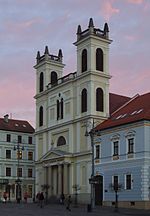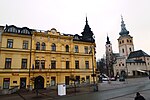Faculty of Political Science and International Relations, Matej Bel University

The Faculty of Political Science and International Relations at Matej Bel University (commonly referred as FPVMV), (Slovak: Fakulta politických vied a medzinárodných vzťahov Univerzity Mateja Bela v Banskej Bystrici) is the international relations school of Matej Bel University. FPVMV offers bachelor's degrees in International Relations and Political Science and, master's degrees in International relations, Security studies, and Political science and also grants doctoral degrees in International Relations, and Political Science. It conducts research in subjects relating to international affairs, security and government. The faculty is recognized as one of the leading international relations teaching and research institutes in Central Europe.FPVMV is noted for having an active student body, various organisations founded by students during their studies at FPVMV went on to become major national and international non-governmental organisations active in the field of international relations and security studies. Since 2009 the faculty headquarters the National Center of Excellence for International Security Studies funded through the RD Program of the EU. FPVMV's alumni and faculty have included multiple ambassadors, diplomats, politicians, and public figures.
Excerpt from the Wikipedia article Faculty of Political Science and International Relations, Matej Bel University (License: CC BY-SA 3.0, Authors, Images).Faculty of Political Science and International Relations, Matej Bel University
Karola Kuzmányho, Banská Bystrica
Geographical coordinates (GPS) Address Nearby Places Show on map
Geographical coordinates (GPS)
| Latitude | Longitude |
|---|---|
| N 48.7327 ° | E 19.1452 ° |
Address
UMB Fakulta politických vied a medzinárodných vzťahov
Karola Kuzmányho 220/1
974 01 Banská Bystrica (Banská Bystrica)
Region of Banská Bystrica, Slovakia
Open on Google Maps








